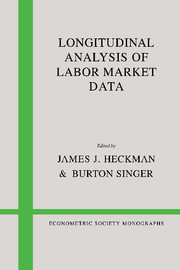Book contents
- Frontmatter
- Part I. Econometric studies
- Part II. Statistical studies
- 5 Weighting, misclassification, and other issues in the analysis of survey samples of life histories
- 6 Statistical models for longitudinal labor market data based on counting processes
- 7 Assessing qualitative features of longitudinal data
- Part III. Sociometric studies
- Name Index
- Subject Index
5 - Weighting, misclassification, and other issues in the analysis of survey samples of life histories
Published online by Cambridge University Press: 05 January 2013
- Frontmatter
- Part I. Econometric studies
- Part II. Statistical studies
- 5 Weighting, misclassification, and other issues in the analysis of survey samples of life histories
- 6 Statistical models for longitudinal labor market data based on counting processes
- 7 Assessing qualitative features of longitudinal data
- Part III. Sociometric studies
- Name Index
- Subject Index
Summary
Introduction
Background and summary
Despite the recent flowering of the literature concerned with methods to analyze human life history segments, comparatively little attention has been given to the particular problems of survey samples of such data. This chapter addresses selected issues of their analysis and provides solutions in a natural manner by combining elements of the relevant individual-based theory of stochastic processes with suitable parts of superpopulationist survey methodology. There are considerable divergences about some of these issues among current analysts, in particular about whether or when one should weight individual responses by means of reciprocal inclusion probabilities. There seems to be a standing dispute between those who would really like to see conventional weights applied in “most” circumstances and others who feel that the case for weighting is much weaker if the analyst wishes to use the data to estimate a properly specified model, since the model presumably “controls for” the effects of the factors which lead to the need for weights in the first place, except perhaps for particular dependent variables in the model. (Formulation essentially taken from PSID, 1983, p. A-13.) Still others may feel that weights are no advantage in model-based analyses.
- Type
- Chapter
- Information
- Longitudinal Analysis of Labor Market Data , pp. 249 - 293Publisher: Cambridge University PressPrint publication year: 1985
- 25
- Cited by

